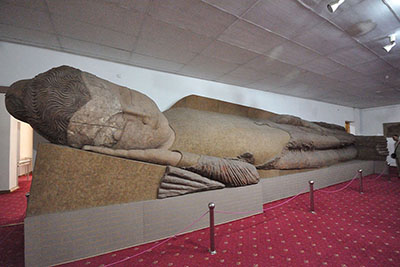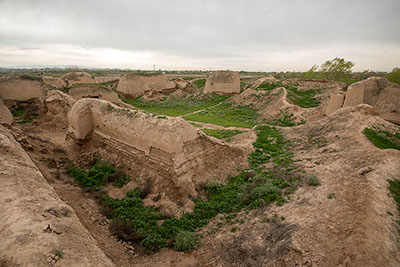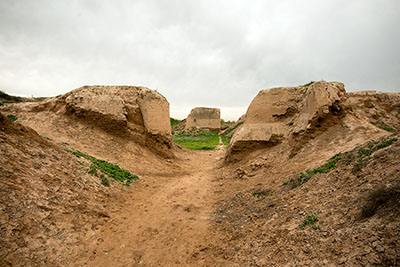The Buddha in Nirvana of Ajina-Teppa
The unique heritage of Buddhism

This is a story about a clay statue of a sleeping Buddha (also called Siddhartha Gautama) which depicts him at the moment of achieving nirvana – liberation from life’s worries and suffering and the conclusion of the cycle of rebirth.
This is the story of a man upon whose face we can look after 1,300 years. It is also a story about a large statue glued together from 72 fragments of ancient clay – a priceless cultural treasure of Tajikistan.
100 kilometers to the south of Dushanbe, there is a town which has been renamed many times during its long history. Now it is called Bokhtar, because it once marked the northern border of the ancient state of Bactria.
Half an hour southeast of Bokhtar is located the township of Kirov, where interned ethnic Germans used to live. And one kilometer from that settlement, there is a village and a hill, nicknamed Ajina-Teppa, or “witch’s hill”.
In the early 1960s, archeologists began excavations on the hill. Nobody knows why this place didn’t arouse interest among historians before. A lonely odd-shaped hill in the middle of the field near the road must have seemed unusual.
Legend has it that a local shepherd saw the outline of a human face, and it scared greatly. Ajina-Teppa was already notorious among superstitious elders. They say that at one time there was even a small village on the hill but the residents had left the mystical place.
Digging underground, archeologists found fragments of stupas, frescos, and reliefs with images of Buddhas, Bodhisattvas, and other deities. The site turned out to be the ruins of a Buddhist monastery and temple dating back to the eighth century. Unfortunately, most of the sculptures had already been disfigured or completely destroyed many centuries prior.
One of these sculptures was first noticed by a local shepherd in 1959, when the rains exposed part of the hill. However, the most amazing find was a 12-meter broken clay statue of a sleeping Buddha, discovered by archaeologists in one of the temple’s narrow and long rooms.
This Buddha is a unique example of Central Asian Buddhist art, and a treasure of world culture. It is a wonderful gift from the past, a fragment of the mosaic of culture and everyday life of our ancestors. The statue predated even the advent of the Tajik language; most likely, the people of that time spoke several other languages and had different identities and religious beliefs.
Buddhism spread through the region in the Middle Ages

During the early Middle Ages and prior to the Arab invasion in the middle of the eighth century A.D., this area of modern Tajikistan was the northern edge of the region of Tokharistan, almost identical to the borders of ancient Bactria. This land was often under the influence of neighboring empires, whose rulers sought to spread their religious preferences.
In those days, the religious landscape of the region was quite diverse. Foreign merchants, soldiers, and religious preachers walked along the Silk Road in caravans. The relative political stability of the empires created favorable conditions for religious tolerance.
Thus, it is not surprising that among the ancestors of modern Tajiks were Zoroastrians, Manicheans, Nestorians (one of the early branches of Christianity) and, of course, Buddhists—followers of Siddhartha Gautama (Buddha the Enlightened), a man who wanted to help people eliminate suffering.
Siddhartha Gautama’s homeland is assumed to be India, but the exact place and year of his birth are still unknown. Some scholars claim that it is located in modern Nepal, while others say that it is the north of India.
There is also the theory that he was a Scythian by birth, a son of one of the Iranian nomadic peoples. This ambiguity makes Buddha look similar to Zarathustra (the Iranian prophet who founded Zoroastrianism), whose date and place of birth are also not clear. Some claim it was Azerbaijan, others point to Khorezm, others believe that was Balkh (ancient Bactra), a city in northern Afghanistan.
The enlightenment of Gautama

It is believed that the Buddha lived in the sixth century B.C. At the age of 29, he secretly left his father’s home, tormented by his search for the meaning of his existence.
At the age of 35, he had overcome the temptations of the gods of Death and Love and achieved the state of “Bodhi”, or enlightenment. Upon reaching his goal, he began to understand how he can help people by becoming a Buddha and preaching. His first sermon was on the teaching of the four noble truths of Buddhism.
Everything that exists is subject to suffering, Gautama taught. The cause of suffering is the thirst for life. Eliminating this desire relieves both the suffering and the need to be reborn an infinite number of times in different forms.
Whether one will be a living creature in the next rebirth is unknown and depends on karma – the set of actions accumulated in the past life. In Buddhism, although the concept of one God as Creator doesn’t exist, there are many gods. Gautama argued that the gods, like humans, do not have power over the law of cause and effect and, therefore, they are not omnipotent. The gods also are subject to karma.
If a person led a righteous life, his existence will be better in the next rebirth. He can be born to become a king, a saint, or even a god. The Buddha himself in his past reincarnations was an animal, a woman, and a king, until he reached enlightenment and broke the chain of rebirth.
After his physical death, Buddha reached nirvana (the state of fading), relieving himself of suffering and ensuring that he would not be reborn again. This is the moment depicted by the ancient sculptor of the sleeping Buddha of Ajina-Teppa. It is difficult to reach nirvana, but it is an achievement worth striving for, the ultimate goal of every Buddhist.
It is possible to refuse nirvana and agree to new reincarnations in order to become a Bodhisattva. This is a creature who achieved the enlightenment of Buddha but comes into this world again and again to show people the way to deliverance and salvation.
Buddhist stupas – ancient reliquaries

In India, stone hemispherical buildings, or stupas, have long been created in places important to the lives of kings and saints. To Buddhists, the stupa served as a reliquary – a repository of holy relics of Buddha or other saints. The stupa could take the form of a bell, a hemisphere, a step pyramid, or, as in Tajikistan, a cross-shaped pyramid.
The most well-preserved stupa of this shape can now be seen in the Pamir Mountains, in the village of Vrang on the border with Afghanistan. These stupas are the most important part of any Buddhist temple. For a Buddhist, it was considered God-pleasing to build a stupa in the same way that contemporary Muslims consider it God-pleasing to repair or build a mosque.
In the temple’s yard of Ajina-Teppa, there was also a stepped stupa made of raw bricks. Since ancient times, this was the most common construction material in Central Asia. Over time, the stupa lost its shape and turned into a three-meter-high clay mound which overlooks the temple and monastery ruins. It takes a lot of imagination to visualize how the site must have looked in the seventh and eighth centuries.
Simple monks preserved history

One of the reasons why there are almost no preserved artifacts of ancient architecture, palaces, temples, and fortresses in Tajikistan is the fragility of construction materials from those days. The most well-preserved architectural monuments date back to the late Middle Ages. By that time, they were already built of stronger and more durable baked bricks.
The only exception are the ruins of fortresses and temples in the Pamir Mountains. They are preserved because unlike in other areas, they were built of stone. Of course, this in the mountains there are many stones, but little clay to build with.
Buildings made of bricks like in Ajina-Teppa need to be constantly restored, which is what monks were constantly engaged with during the time the monastery was in active use.
Traces of this ancient restoration were found at the place where the plaster had collapsed. It seems that fragments of mural paintings were either restored (but not with the same grace and artistic skill as from the previous masters), or simply painted over.
Traces of fire damage can also be seen in one of the monastery rooms. We do not know the cause of the fire—perhaps, oil spilled from a lamp—but there is ancient soot found on the walls.
In those days, people would rarely install windows; instead, light and air penetrated through the doors or through a hole in the ceiling. Of course, this was not because the ancient architects did not have enough skill to make windows in their walls. During summer in southern Tajikistan, the temperature often rises to 45 degrees Celsius. Two-and-a-half-meter-thick walls and no windows allowed those in the monastery and temple to keep cool. On the other hand, you can imagine the air in the rooms – a mixture of incense aromas, flowers and offerings, smoke from grease lamps, and the smells of monks’ and parishioners’ bodies.
Ajina-Teppa was a small monastery, where only 30-40 monks could live simultaneously. There is a legend that underground passages from the monastery to distant cells sprawled in several directions. These underground corridors collapsed long ago, but half a kilometer around Ajina-Tepe, one can see small hills that are apparently not of natural origin.
A masterpiece of Asian medieval sculpture

Thanks to archeologists, we know how ancient sculptors made the clay Buddha statue. It is most likely that the statue was sculpted in the open air, and the temple walls were erected simultaneously with the sculpture. Once the statue was finished, the vaulted ceiling of the temple was laid, and the sculpture plunged into darkness, because the builders installed neither windows nor gaps for light.
The ancient masters were well aware of the short lifespan of “pakhsa” (pressed clay) and raw clay, and so they approached creating the statue of their deity with great responsibility.
The sculptor and his apprentices carefully tempered the clay, kneaded it for several days, mixed it with fine straw, and left it to rest. Then they kneaded it again until the clay turned into a plastic, putty-like, mass.
Afterwards, the clay was soaked in water several times until all salts were rinsed out of it. In historical chronicles, there is a description how Central Asian builders would test their clay before construction. Bags filled with finished clay were laid upon both sides of a donkey or a horse and the animal would float down the river. If the water did not wash the clay out of the bags the quality was good enough to form bricks.
The platform of “Buddha in Nirvana” is made of raw bricks. As soon as the contours of the future statue were shaped, the monks coated the pedestal with soft clay from the finely sifted ground and then began to create the sculpture itself.
All elements of the figure from the Buddha’s wavy hair to the nails of his fingers and wrinkles of clothes were made meticulously, with the highest skill. The finished statue was primed with a thin layer of plaster and painted—hands and face in white, and clothes in ochre. This faded gingery-red color can barely be seen in the folds of Buddha’s clothing.
The “New Life” of the Buddha from Ajina-Teppa
Unlike other temples after the Buddhists left Central Asia, the temple and monastery at Ajina-Teppa were not turned into a mosque. Judging by the remains of kilns, part of the complex became a pottery workshop, suggesting that at some point, artisans lived and worked on the premises of the former Buddhist monastery.
The temple part of the complex began to deteriorate due to lack of care. However, mural paintings, fragments of statues, coins, a miniature copy of a large stupa, and other items have been preserved. Nowadays, you can see them in collections at the National Museum of Tajikistan, the National Museum of Antiquities in Dushanbe, and Hermitage in St. Petersburg.
In 1999, the Buddha statue was fully restored and became a national treasure. Two years later, in the Bamyan province of neighboring Afghanistan, unique rock bas-reliefs of Buddhas were brutally destroyed by the Taliban. These historical treasures no longer exist, and a copy, if ever created, will certainly not arouse as much awe as the original among either believers or tourists.
After the destruction of the Bamiyan Buddhas, the Buddha of Ajina-Teppa became an even more valuable artifact – the most famous and well-preserved monument of Buddhist art in general and Central Asian Buddhism in particular.
In contrast to the destruction of historical monuments in Afghanistan, this preservation shows Tajik respect for their pre-Islamic past and ancestors, some of whom were undoubtedly Buddhists.
The statue of the Buddha from Ajina-Teppa was surprisingly luckier than the Bamiyan bas-reliefs, although at one point, seemed not the case. The clay sculpture was badly damaged, especially Buddha’s chest and left hand. A large fragment of the head and face survived.
Mistakes in previous preservation work also caused damage to some fragments of the statue. Despite the fact that almost half of the figure is a “replica”, one can feel the integrity and authenticity of the sculpture.
In 2001, on the eve of the tenth anniversary of Tajikistan’s independence, the U.S. Embassy in Dushanbe sponsored a project to restore the ancient statue of the “sleeping Buddha” at a cost of $30,000. The Ambassador’s Fund for Cultural Preservation also provided assistance to construct safe display cases for the museum’s other exhibits. The entire collection has been transferred to a digital photo archive.
List of references:
- Brodsky B.I. Romantic vedoubts. Moscow, “Soviet Artist”, 1966
- Litvinsky B.I., Zemal T.I. Ajina-Tepa. , “Art”, 1971
- About the book “Greek Buddha. Pyrron’s meeting with early Buddhism in Central Asia”



